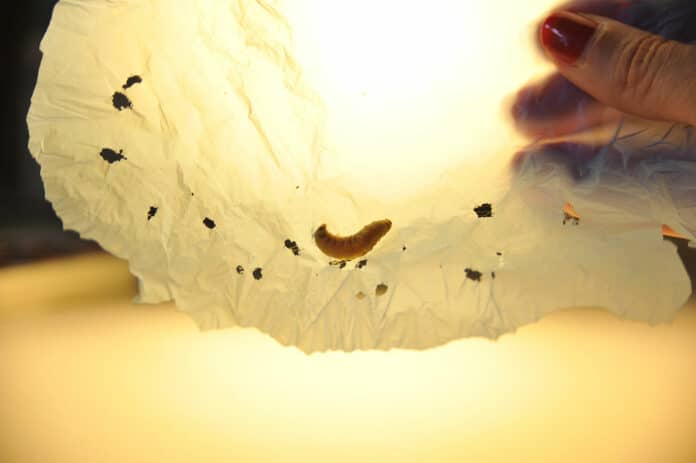Plastic pollution poses a threat to the planet’s health and environment, and biodegradation by microorganisms such as bacteria and fungi is proposed as a possible solution to tackle the plastic waste problem. However, to date, only a handful of microorganisms are known to break down the tough plastic polymers forming polyethylene. In most cases, aggressive pre-treatment is needed to guarantee oxidation and thus enable the microorganisms to exert some effect on the plastic.
A team of researchers in Spain have just discovered that the saliva of wax worm species of Galleria mellonella contains enzymes able to degrade plastics in hours at room temperature. The discovery of these enzymes, which belong to the phenol oxidase family and can rapidly set off polyethylene, opens up an array of applications for treating or recycling plastic waste.
The wax moth worm is capable of degrading the chemical bonds of polyethylene, a polymer widely produced synthetic and plastic used in packaging, bags, and other everyday materials. Federica Bertocchini, a biology researcher and beekeeper in Spain, discovered the ability of this insect by chance several years ago.
“For plastic to degrade, oxygen must penetrate the polymer (the plastic molecule). This is the first step in oxidation, which is usually a result of exposure to sunlight or high temperatures, and represents a bottleneck that slows down the degradation of plastics like polyethylene, one of the most resistant polymers,” explains Bertocchini. “That is why, under normal environmental conditions, plastic takes months or even years to degrade,” she adds.
She said the plastic-eating enzymes they discovered are the first and only known enzymes capable of degrading polyethylene plastic by oxidizing and breaking down the polymer very rapidly (after just a few hours of exposure) without requiring pre-treatment and work at room temperature.
Researchers analyzed the saliva using electron microscopy and observed a high protein content from which two enzymes were isolated and identified. These two proteins, Demetra and Ceres, belong to the family of phenol oxidase enzymes. They found that the Demetra enzyme had a significant effect on polyethylene, leaving marks (small craters) on the surface of the plastic visible to the naked eye.
Additionally, degradation products are formed after exposure of the polyethylene to this enzyme. The Ceres enzyme oxidizes the polymer, too but does not leave visible marks, suggesting that the two enzymes have a different effect on polyethylene.
Mechanisms by which these enzymes are able to degrade plastic are still unknown and more research combining insect biology with biotechnology is required.
Journal reference:
- A. Sanluis-Verdes, P. Colomer-Vidal, F. Rodriguez-Ventura, M. Bello-Villarino, M. Spinola-Amilibia, E. Ruiz-Lopez, R. Illanes-Vicioso, P. Castroviejo, R. Aiese Cigliano, M. Montoya, P. Falabella, C. Pesquera, L. Gonzalez-Legarreta, E. Arias-Palomo, M. Solà, T. Torroba, C. F. Arias and F. Bertocchini. Wax worm saliva and the enzymes therein are the key to polyethylene degradation by Galleria mellonella. Nature Communications 13, 5568 (2022). DOI: 10.1038/s41467-022-33127-w
